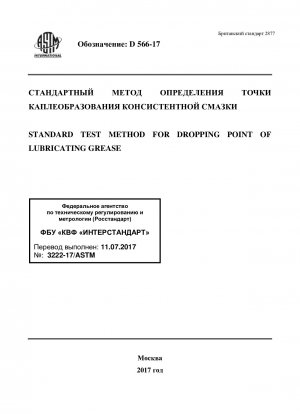ASTM D566-17
Standard Test Method for Dropping Point of Lubricating Grease
- Standard No.
- ASTM D566-17
- Release Date
- 2017
- Published By
- American Society for Testing and Materials (ASTM)
- Status
- Replace By
- ASTM D566-20
- Latest
- ASTM D566-20
- Scope
-
5.1 In general, the dropping point is the temperature at which the grease passes from a semisolid to a liquid state under the conditions of test. This change in state is typical of greases containing as thickeners soaps of conventional types. Greases containing as thickeners materials other than conventional soaps can, without change in state, separate oil. This test method is useful to assist in identifying the grease as to type and for establishing and maintaining bench marks for quality control. The results are considered to have only limited significance with respect to service performance as dropping point is a static test.
Note 1: Cooperative testing indicates that in general, dropping points by Test Method D5663 and Test Method D2265 are in agreement. In cases where results differ, there is no known significance. However, agreement between producer and consumer as to the test method used is advisable.
1.1 This test method covers the determination of the dropping point of lubricating grease.
1.2 This test method is not recommended for use at bath temperatures above 2888201;°C. For higher temperatures Test Method D2265 should be used.
1.3 The values stated in SI units are to be regarded as standard. No other units of measurement are included in this standard.
1.4 WARNING—This test method uses mercury-filled thermometers. Mercury has been designated by many regulatory agencies as a hazardous material that can cause central nervous system, kidney and liver damage. Mercury, or its vapor, may be hazardous to health and corrosive to materials. Caution should be taken when handling mercury and mercury containing products. See the applicable product Safety Data Sheet (SDS) for details and EPA’s website— http://www.epa.gov/mercury/faq.htm—for additional information. Users should be aware that selling mercury and/or mercury containing products into your state or country may be prohibited by law. The responsible subcommittee, D02.G.3, continues to explore alternatives to eventually replace the mercury thermometers.
1.5 This standard does not purport to address all of the safety concerns, if any, associated with its use. It is the responsibility of the user of this standard to establish appropriate safety and health practices and determine the applicability of regulatory limitations prior to use. For specific hazard statements, see 6.4 and 8.1.
1.6 This international standard was developed in accordance with internationally recognized principles on standardization established in the Decision on Principles for the Development of International Standards, Guides and Recommendations issued by the World Trade Organization Technical ......
ASTM D566-17 Referenced Document
- ASTM D217 Standard Test Methods for Cone Penetration of Lubricating Grease
- ASTM D2265 Standard Test Method for Dropping Point of Lubricating Grease Over Wide Temperature Range
- ASTM D235 Standard Specification for Mineral Spirits (Petroleum Spirits) (Hydrocarbon Dry Cleaning Solvent)
- ASTM E1 Standard Specification for ASTM Thermometers
ASTM D566-17 history
- 2020 ASTM D566-20 Standard Test Method for Dropping Point of Lubricating Grease
- 2017 ASTM D566-17 Standard Test Method for Dropping Point of Lubricating Grease
- 2016 ASTM D566-16 Standard Test Method for Dropping Point of Lubricating Grease
- 2002 ASTM D566-02(2009) Standard Test Method for Dropping Point of Lubricating Grease
- 2002 ASTM D566-02 Standard Test Method for Dropping Point of Lubricating Grease
- 1997 ASTM D566-97e1 Standard Test Method for Dropping Point of Lubricating Grease
- 1997 ASTM D566-97 Standard Test Method for Dropping Point of Lubricating Grease
- 1982 ASTM D566-76(1982)e1 Standard Test Method for Dropping Point of Lubricating Grease
- 1976 ASTM D566-76 Standard Test Method for Dropping Point Of Lubricating Grease

Copyright ©2024 All Rights Reserved